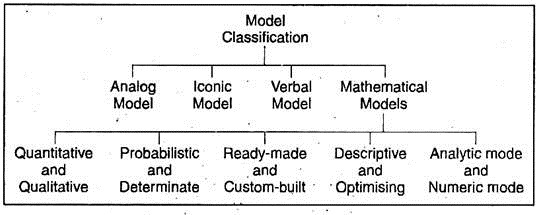There are several basic kinds of models used for making business decisions. The models are:- 1. Analog Model 2. Iconic Model 3. Verbal Model 4. Mathematical Model.
1. Analog Model:
An ‘analog’ model is a physical representation of the real world. A mock-up of an airplane is an analog model. An architect may place a mock-up of a building to examine the characteristics of alternative designs. Such models are always reduced in size.
2. Iconic Model:
An ‘iconic’ model is one which does not act like the real thing (as the analog model does) but only looks like it. For example, a road map or an organisation chart.
A road map abstracts the facts like distance, direction, kinds of highways, bridges and tunnels, etc. needed by a driver. Similarly, in an organisation chart, the boxes represent specific offices or formal roles and the lines represent channels of communications and reporting relationships.
3. Verbal Model:
It involves a verbal description of a real situation. Language, written or spoken, is employed to abstract the relevant factors or characteristics. A newspaper description of a football game is a verbal model.
4. Mathematical Model:
This model employs mathematical manipulation of symbols to abstract and represent the behaviour of a real-world system. The use of electronic computers has led to the rapid and wide adoption of mathematical models in managerial decisions. A complex series of mathematical formulae representing the growth of Indian economy can be classified as a model.
Following is a simple example of a mathematical expression which could be classified as a model:
Let us assume that the final product C takes two units of raw material A and five units of raw material B to manufacture C. Let the costs of A is Rs. 30 per unit, and the cost of B is Rs. 80 per unit. Therefore, 2A + 5B = C is the relationship.
The cost of producing C becomes: 2 x 30 + 5 x 80 = Rs. 460. This is the cost-predicting model for producing the product C. If the cost of either A or B changes, or if the quantities of A or B required to C change, then the effect on the cost of C can be determined and so, predicted.
